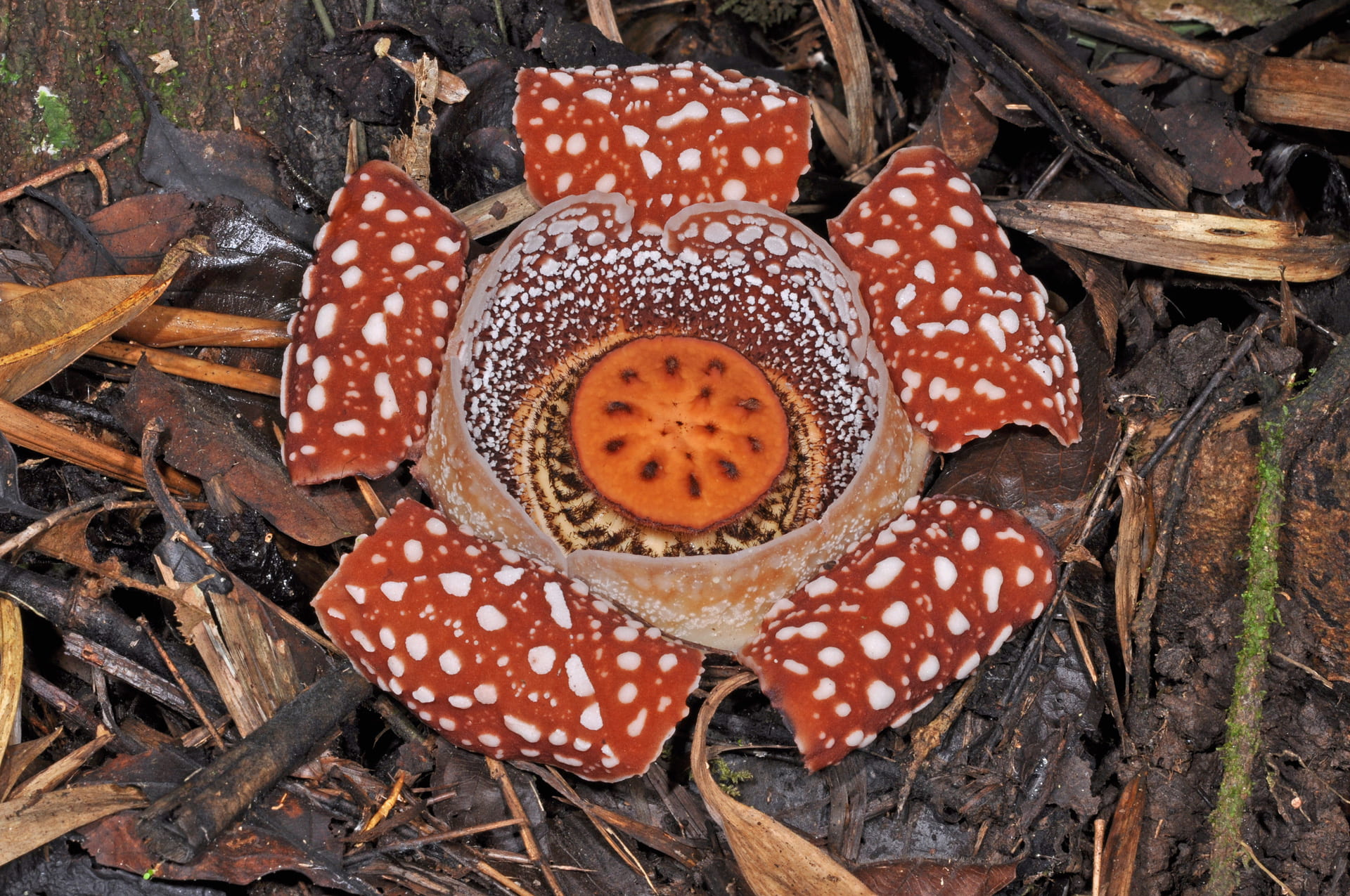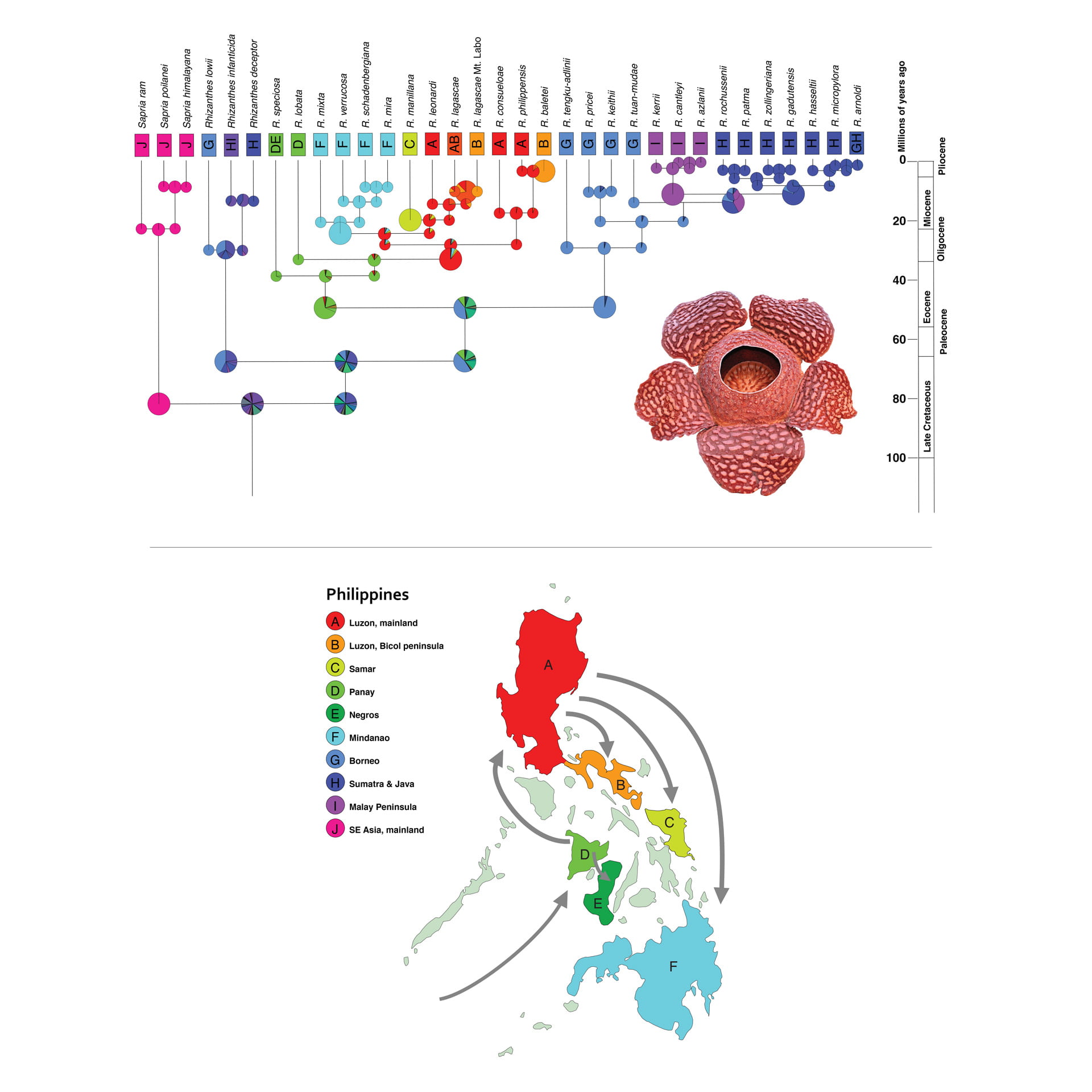Parasites are paradigm breakers: they challenge our concepts of how organisms function and evolve. Rafflesia is amongst the most spectacular of parasitic plants. This Southeast Asian genus is not only the record-holder for ‘Largest Flowers In The World’, but is also peculiar in lacking the parts that a more typical plant has: they don’t have roots, stems and leaves. Rafflesia does not need these parts, because it steals water, sugars, and everything else it needs to grow from the plant species that it parasitises. Rafflesia plants live entirely inside these ‘host plants’ and their flowers are the only parts that emerge from them.

Biological knowledge as the foundation for Rafflesia conservation
In the past 15 years or so, Dr. Julie Barcelona (UC Biological Sciences) and I have been studying Rafflesia in the Philippines1. In collaboration with our colleagues, we discovered and named several new species2,3,4. We learned more about the plant species that Rafflesia parasitizes5, how its seeds are dispersed6, and how genetically diverse and unique its populations are7,8. All this information is important for informing the conservation management of Rafflesia. This is crucial, because most species are extremely rare and their tropical forest habitats are rapidly disappearing.

Why are most Rafflesia species only known from individual islands?
In our most recent publication9, we set out to determine why most Rafflesia species are only present on individual islands in the Philippine archipelago. We hypothesised that this distribution pattern is a result of poor seed-dispersal across the straits and seas that separate the Philippine islands. A reconstruction of the evolutionary history of the genus using DNA sequence data helped us to understand when and how Rafflesia colonised, speciated, and spread across the Philippines, confirming our suspicion that inter-island dispersal is very rare. These results provide a framework for further studies into the evolution and conservation of these remarkable parasites.

References
- Barcelona, J. F., P. B. Pelser, D. S. Balete, and L. L. Co. 2009. Taxonomy, ecology, and conservation status of Philippine Rafflesia. Blumea 54:77-93.
- Barcelona, J. F., P. B. Pelser, E. M. Cabutaje, and N. A. Bartolome. 2008. Another new species of Rafflesia (Rafflesiaceae) from Luzon, Philippines: R. leonardi. Blumea 53:223-228.
- Barcelona, J. F., M. M. E. Manting, R. B. Arbolonio, R. B. Caballero, and P. B. Pelser. 2014. Rafflesia mixta (Rafflesiaceae), a new species from Surigao del Norte, Mindanao, Philippines. Phytotaxa 174:272-278.
- Balete, D. S., P. B. Pelser, D. L. Nickrent, and J. F. Barcelona. 2010. Rafflesia verrucosa (Rafflesiaceae), a new species of small-flowered Rafflesia from eastern Mindanao, Philippines. Phytotaxa 10:49-57.
- Pelser, P. B., D. L. Nickrent, and J. F. Barcelona. 2016. Untangling a vine and its parasite: host specificity of Philippine Rafflesia (Rafflesiaceae). Taxon 65:739-758.
- Pelser, P. B., D. L. Nickrent, J. R. C. Callado, and J. F. Barcelona. 2013. Mt. Banahaw reveals: The resurrection and neotypification of the name Rafflesia lagascae (Rafflesiaceae) and clues to the dispersal of Rafflesia seeds. Phytotaxa 131:35–40.
- Pelser, P. B., D. L. Nickrent, C. E. C. Gemmill, and J. F. Barcelona. 2017. Genetic diversity and structure in the Philippine Rafflesia lagascae complex (Rafflesiaceae) inform its taxonomic delimitation and conservation. Systematic Botany 42:543-553.
- Pelser, P. B., D. L. Nickrent, and J. F. Barcelona. 2018. A conservation genetic study of Rafflesia speciosa (Rafflesiaceae, Philippines): patterns of genetic diversity and differentiation within and between islands. Blumea 63:93-101.
- Pelser, P. B., D. L. Nickrent, B. W. van Ee, and J. F. Barcelona. 2019. A phylogenetic and biogeographic study of Rafflesia (Rafflesiaceae) in the Philippines: Limited dispersal and high island endemism. Molecular Phylogenetics and Evolution 139:106555.
—
Pieter Pelser is a plant systematist with an interest in the documentation and conservation of botanical biodiversity and understanding evolutionary patterns and processes.













